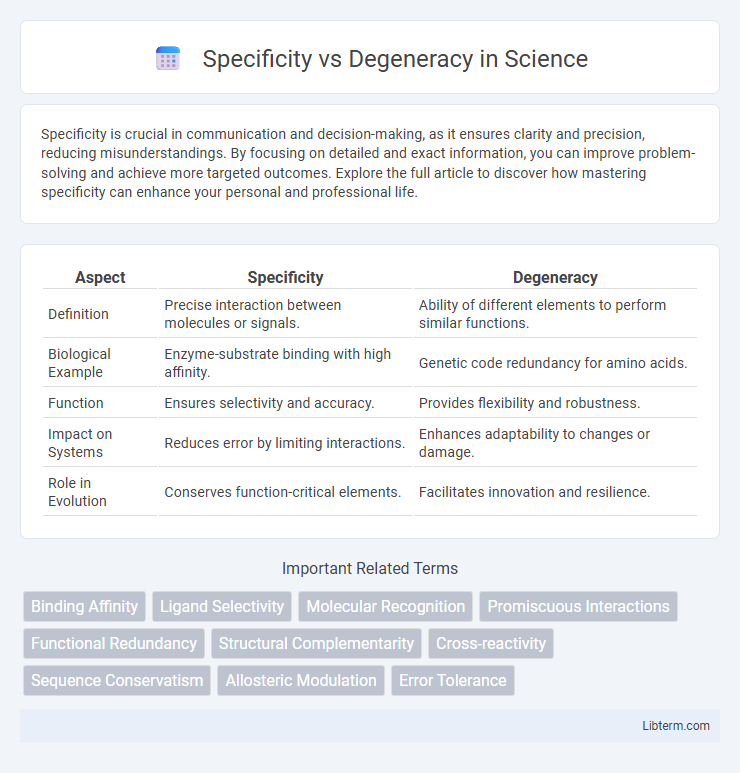Specificity is crucial in communication and decision-making, as it ensures clarity and precision, reducing misunderstandings. By focusing on detailed and exact information, you can improve problem-solving and achieve more targeted outcomes. Explore the full article to discover how mastering specificity can enhance your personal and professional life.
Table of Comparison
| Aspect | Specificity | Degeneracy |
|---|---|---|
| Definition | Precise interaction between molecules or signals. | Ability of different elements to perform similar functions. |
| Biological Example | Enzyme-substrate binding with high affinity. | Genetic code redundancy for amino acids. |
| Function | Ensures selectivity and accuracy. | Provides flexibility and robustness. |
| Impact on Systems | Reduces error by limiting interactions. | Enhances adaptability to changes or damage. |
| Role in Evolution | Conserves function-critical elements. | Facilitates innovation and resilience. |
Understanding Specificity in Biological Systems
Specificity in biological systems refers to the precise interaction between molecules, such as enzymes binding to their substrates or receptors recognizing particular ligands, ensuring accurate cellular functions. This molecular recognition is fundamental for processes like signal transduction, immune response, and metabolic pathways, where exact interactions determine outcomes. High specificity minimizes cross-reactivity and errors, enhancing the fidelity and efficiency of biological mechanisms.
Defining Degeneracy: An Overview
Degeneracy refers to the ability of elements within a system to perform similar functions despite differences in structure or composition, allowing flexibility and robustness in biological and computational processes. Unlike specificity, which emphasizes a one-to-one relationship between a component and its function, degeneracy embraces many-to-one mappings, enhancing adaptability and resilience. This concept is critical in understanding neural networks, genetic codes, and complex adaptive systems, where overlapping functionalities contribute to system stability.
Core Differences Between Specificity and Degeneracy
Specificity refers to a system's ability to respond distinctively to particular inputs, ensuring precise and narrow functions, whereas degeneracy involves multiple components performing similar functions, allowing systems flexibility and robustness. Core differences lie in specificity's emphasis on unique, one-to-one mappings between signals and responses, contrasting with degeneracy's many-to-one or one-to-many mappings that enable adaptability across varying conditions. These contrasting mechanisms highlight specificity's role in precision and degeneracy's contribution to resilience in complex biological and computational networks.
Molecular Mechanisms Underlying Specificity
Molecular mechanisms underlying specificity involve precise interactions between biomolecules, such as enzyme-substrate binding, receptor-ligand recognition, and DNA-protein affinity, which are governed by structural complementarity and non-covalent forces like hydrogen bonds and van der Waals interactions. Specificity is achieved through highly selective active sites and conformational changes that enable exclusive binding to target molecules, ensuring accurate cellular signaling and metabolic reactions. In contrast, degeneracy refers to the ability of multiple molecular components to perform similar functions, which introduces redundancy and robustness within biological systems.
The Role of Degeneracy in Robustness
Degeneracy in biological systems refers to the ability of structurally different components to perform overlapping functions, contributing significantly to system robustness by providing functional redundancy and adaptability. Unlike specificity, which involves precise one-to-one interactions, degeneracy allows systems to maintain stable performance despite environmental perturbations or internal failures. This multifaceted functional overlap enhances resilience, enabling organisms to adapt dynamically to changing conditions and maintain homeostasis.
Functional Implications in Neural Networks
Specificity in neural networks ensures that neurons and synapses respond selectively to particular stimuli, promoting precise information processing and efficient signal transmission. Degeneracy provides functional redundancy by allowing different neural elements to perform similar roles, enhancing the network's robustness and adaptability under varying conditions. The balance between specificity and degeneracy enables neural circuits to maintain reliable cognitive functions while flexible enough to recover from damage or adapt to learning.
Evolutionary Perspectives: Specificity vs Degeneracy
From an evolutionary perspective, specificity refers to the precise adaptation of biological systems to perform distinct functions, enhancing survival through optimized efficiency. Degeneracy, in contrast, denotes the ability of structurally different elements to perform similar functions, promoting robustness and flexibility in evolving environments. This balance between specificity and degeneracy facilitates both adaptability and resilience, enabling species to thrive under diverse selective pressures.
Specificity and Degeneracy in Disease Mechanisms
Specificity in disease mechanisms refers to the precise interaction between a pathogen or molecular factor and a specific target, such as a receptor or cell type, which leads to a particular pathological outcome. Degeneracy describes the capability of different molecular or cellular pathways to produce the same disease phenotype, highlighting the redundancy and complexity within biological systems. Understanding the balance between specificity and degeneracy is crucial for developing targeted therapies and predicting disease progression in conditions like cancer, autoimmune disorders, and infectious diseases.
Real-World Examples Illustrating Both Concepts
In biological systems, specificity refers to the precise interaction between enzymes and substrates, such as the lock-and-key model of enzyme activity, ensuring accurate metabolic pathways. Degeneracy manifests in the genetic code where multiple codons encode the same amino acid, providing resilience against mutations. Neural networks in the brain also exhibit degeneracy by allowing different neural circuits to produce similar functions, enhancing adaptability and robustness.
Future Directions in Specificity and Degeneracy Research
Future directions in specificity and degeneracy research emphasize the integration of multi-omics data to uncover complex molecular interactions and their roles in biological robustness. Advanced machine learning models are being developed to predict degeneracy patterns across different biological systems, enhancing the precision of targeted therapies. Emerging experimental techniques aim to manipulate specificity and degeneracy in real-time, facilitating dynamic control of cellular functions for personalized medicine.
Specificity Infographic

 libterm.com
libterm.com